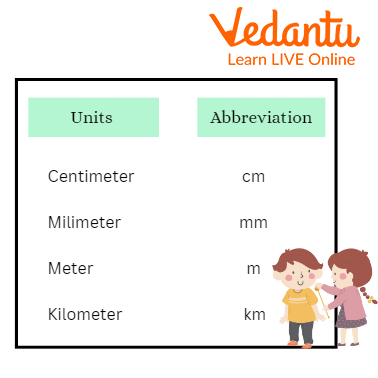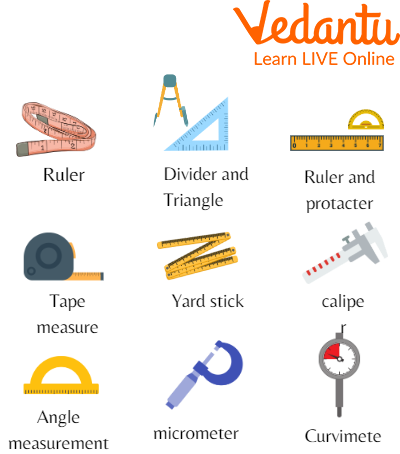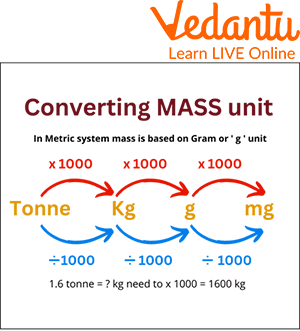




How to Convert and Compare Smaller Units of Length
A unit of length is primarily used in the mathematical world. Measuring length means measurement of the length of any object with the help of measuring tools like a ruler, measuring tape, etc. For example, the length of a pencil can be measured in inches using a ruler. The height of students in a class can be measured using a feet scale. There are units of length like inches, centimetres, metres, feet, etc.
To convert larger units to smaller units, we multiply, and vice versa, we divide. This is a very simple process to convert larger units to smaller units. Another process of doing this, i.e., to convert a bigger unit to a smaller unit, we shift the decimal point to the right. Interestingly, this process is very commonly used in our daily lives.
Units for Measuring Length
To measure length, there are different units. The bigger unit of measuring length is known to be kilometres. On the other hand, to measure smaller units of length, we use decimeters, centimetres, and millimetres. The standard unit of length is “metre”, which is written as ‘m’.
Normally, a metre length is divided into 100 equal parts. Interestingly, each of these parts is named centimetres, known as ‘cm’. Moreover, we could say 1 m = 100 cm and 100 cm = 1 m. For the bigger unit, kilometres are used, which equals 1000 metres, and kilometres are written as ‘km’ in short. We could say that 1 kilometre = 1000 metres and 1000 m = 1 km.

Units of Measuring Length
Below is a table that talks of equivalents of different units of length.
To convert kilometres into metres, one needs to multiply 1000. To convert metres into kilometres, one needs to divide it by 1000.
Tools to Measure Length
To measure the length of any object or article, we require the right tool. If the right tool is not provided, then there might be a change in the result. In the same way, some important tools are required to measure length. These tools are used to measure both long and short lengths.
Some tools to measure length are as follows:-
Ruler
Tapes
Feet/Foot
Yardsticks
metre sticks
Calliper
Micrometre
Roll Meter
Some tools like the roll metre, calliper, metre sticks, and feet/foot are all used to measure long lengths. On the other hand, the smaller lengths are measured using a ruler, micrometre, calliper, and many more.

Tools for Measuring Length
Smaller Units of Mass
Many of you might have heard the word ‘mass’. It is the dimensionless quantity that represents the amount of matter in a particle. In the International System, the standard unit of mass is the kilogram (kg).
The two smaller units of mass measurement are kilogram and gram. Interestingly, a milligram is the smallest unit of mass. The prefix ‘kilo’ literally means a thousand on the other hand, ‘milli’ means one-thousandths. The basic unit of mass is the gram and is used in many parts of the world.
The equivalence of different units of mass is given below:
1 kilogram (kg) = 1,000 grams (g)
1 milligram (mg) = 0.001 gram (g)
Here, to convert a bigger unit to a smaller unit, we multiply it by a power of ten. This will further help the decimal move to the right. On the other hand, to convert grams to milligrams, one needs to multiply it by 1000.
In the case of mass, these were some ways to convert bigger units to smaller units.
Now, to convert smaller units to larger units, one needs to divide to the power of ten. This will further help to move the decimal to the left side.
1 mg ÷ 1,000 = 0.001 g
1 g ÷ 1,000 = 0.001 kg

Converting Mass to Other Units Process
Solved Examples
Here are some simple examples to convert a unit of mass or length.
1. Change 7165 kg into quintals.
Ans: We need to calculate 7165 =? Quintals
Since 100 kg = 1 quintal
So, 7165 kg ÷ 100 = 71 quintals 65 kg
Therefore, 7165 kg equals 71 quintals 65 kg.
2. Change 345 cm into m.
Ans: As we need to calculate,
345 cm =? m
Since 1 m = 100 cm
So, 345 cm = 345 ÷ 100 = 3.45 m
Therefore, the result of conversion is 3.45 m.
Practice Questions
1. Fill in the blank:
To convert a larger unit to a smaller unit, we _________.
Ans: Multiply it by powers of 10 or shift the decimal point to the right.
2. Convert 45.65 kg to a gram.
Ans: 45650 g.
3. Change 1000 centimetres to metres.
Ans: 10.
Summary
Mathematics is an interesting subject to study. The calculation and conversion of the metric system make it more interesting for kids. Now, in this article, we are clear on how to convert larger units to smaller units, and smaller into bigger, two smaller units of mass, and smaller units of length. Here, we understand that to convert a larger value to a smaller one, we multiply it by the powers of 10. Some solved examples are also given that illustrate the method of conversion more deeply.
FAQs on Mastering Smaller Units of Length
1. What are the smaller units of length we use in daily life?
Smaller units of length are used to measure objects that are too small to be measured accurately in metres. The most common smaller units of length as per the CBSE syllabus are the centimetre (cm) and the millimetre (mm). These units help us get precise measurements for small items like a pencil, an eraser, or the thickness of a book.
2. How are a metre, a centimetre, and a millimetre related to each other?
The relationship between these units is fundamental for converting measurements and understanding size. The standard conversions are:
- 1 metre (m) = 100 centimetres (cm)
- 1 centimetre (cm) = 10 millimetres (mm)
This shows that a centimetre is 100 times smaller than a metre, and a millimetre is 10 times smaller than a centimetre.
3. What are some real-world examples of things measured in centimetres and millimetres?
We use these smaller units frequently in our daily activities. For example:
- Centimetres (cm) are perfect for measuring the length of a crayon, the width of a mobile phone, or the height of a small plant.
- Millimetres (mm) are used for even smaller dimensions, such as the thickness of a credit card, the width of a pencil tip, or the length of a tiny insect.
4. Why do we need smaller units of length instead of just using metres for everything?
The primary reason we need smaller units like centimetres (cm) and millimetres (mm) is for accuracy. If you tried to measure the length of your fingernail in metres, you would get a very small decimal number (like 0.01 m), which is hard to read and use. Smaller units provide a more convenient and precise whole number (like 1 cm) for measuring small objects.
5. How can I decide whether to use centimetres (cm) or millimetres (mm) to measure an object?
A simple way to decide is to look at the object's size and the level of detail you need.
- Use centimetres (cm) for common small items that you can easily see and handle, like a key or a piece of chalk.
- Use millimetres (mm) when you need a highly precise measurement for very fine or tiny things, like the thickness of a wire or the space between lines in a notebook.
6. How do the markings on a standard school ruler represent smaller units of length?
A standard school ruler is a perfect visual guide to these units. The longer, numbered lines (e.g., 0, 1, 2, 3...) on the ruler mark the centimetres (cm). The very small, unnumbered lines packed between each centimetre are the millimetres (mm). You will count exactly 10 of these tiny millimetre spaces inside every one-centimetre gap.
7. Is millimetre the smallest possible unit for measuring length?
In the context of the NCERT syllabus for your class (2025-26), the millimetre (mm) is the smallest unit of length you will typically work with. However, in advanced science, scientists use even smaller units to measure microscopic things. For example, a micrometre is used to measure bacteria. For all practical purposes in school and daily life, the millimetre is a very small and useful unit of measurement.

















